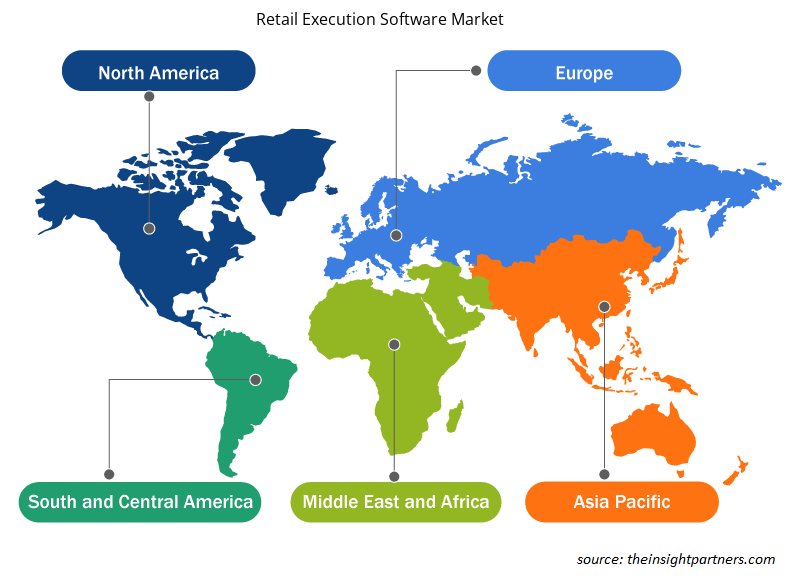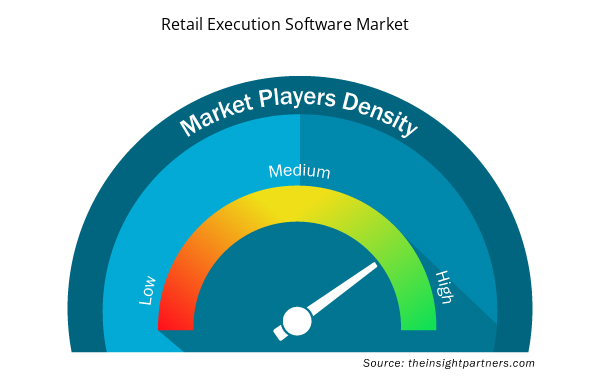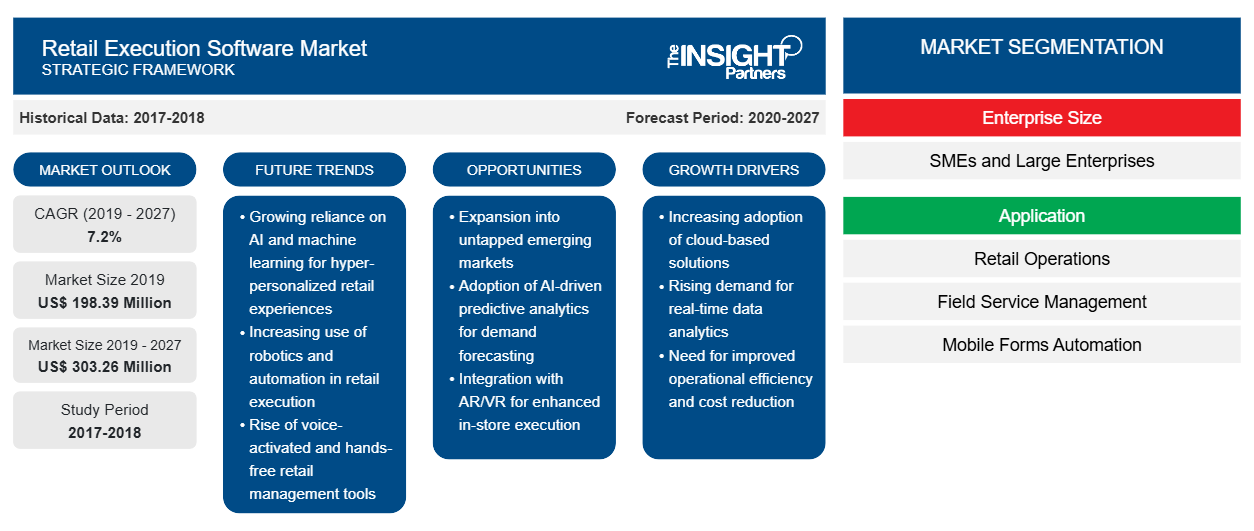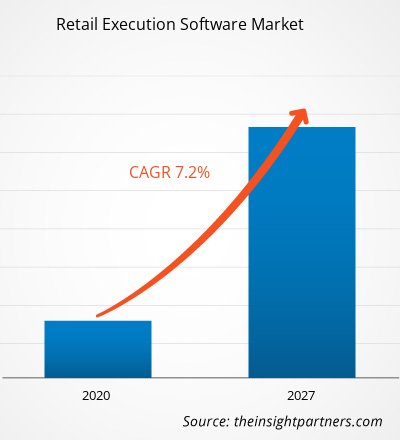بلغت قيمة سوق برمجيات تنفيذ التجزئة 198.39 مليون دولار أمريكي في عام 2019 ومن المتوقع أن تصل إلى 303.26 مليون دولار أمريكي بحلول عام 2027؛ ومن المتوقع أن ينمو بمعدل نمو سنوي مركب قدره 7.2٪ من عام 2020 إلى عام 2027.
يشهد سوق برامج تنفيذ التجزئة العالمية نموًا كبيرًا بسبب التفضيل المتزايد لمنصات التجزئة والتجارة الإلكترونية والتكامل المتزايد لبوابات الدفع مع برامج تنفيذ التجزئة. بناءً على الجغرافيا، قادت أمريكا الشمالية السوق بحصة إيرادات بلغت 31.13٪، تليها أوروبا ومنطقة آسيا والمحيط الهادئ. إن وجود اقتصاد سريع النمو، والاعتماد المتزايد على التكنولوجيا الآلية، والانتشار المتزايد للإنترنت، والاعتماد الهائل للبرامج من قبل المستخدمين النهائيين هي من بين العوامل الرئيسية المتوقعة لدفع نمو سوق برامج تنفيذ التجزئة في هذه المناطق. من المتوقع أن ينمو سوق برامج تنفيذ التجزئة في منطقة آسيا والمحيط الهادئ بأعلى معدل نمو سنوي مركب خلال فترة التنبؤ. يؤدي التبني المتزايد للتكنولوجيات المتقدمة في صناعة التجزئة إلى دفع معدل تبني برامج تنفيذ التجزئة. تستثمر الشركات في البرامج لتبسيط عملياتها التجارية. في منطقة آسيا والمحيط الهادئ، تعد الهند والصين أسرع الأسواق نموًا لتجارة التجزئة والتجارة الإلكترونية. يميل المستهلكون في هذه البلدان بشدة إلى التسوق عبر الإنترنت بسبب انتشار الإنترنت المتزايد، وتعمل اتجاهات التسوق عبر الإنترنت على تحويل العديد من مجالات تجارة التجزئة والتجارة الإلكترونية في المنطقة. وبالتالي، تعمل هذه العوامل على دفع نمو سوق برمجيات تنفيذ عمليات البيع بالتجزئة في منطقة آسيا والمحيط الهادئ. ومن المتوقع أيضًا أن تنمو مناطق نامية أخرى، مثل منطقة الشرق الأوسط وأفريقيا وجنوب آسيا، بوتيرة ثابتة بسبب المبادرات الحكومية المتزايدة لرقمنة الاقتصاد من خلال تبني التقنيات المتقدمة.
قم بتخصيص هذا التقرير ليناسب متطلباتك
ستحصل على تخصيص لأي تقرير - مجانًا - بما في ذلك أجزاء من هذا التقرير، أو تحليل على مستوى الدولة، وحزمة بيانات Excel، بالإضافة إلى الاستفادة من العروض والخصومات الرائعة للشركات الناشئة والجامعات
- احصل على أهم اتجاهات السوق الرئيسية لهذا التقرير.ستتضمن هذه العينة المجانية تحليلاً للبيانات، بدءًا من اتجاهات السوق وحتى التقديرات والتوقعات.
تأثير جائحة كوفيد-19 على سوق برامج تنفيذ البيع بالتجزئة
وفقًا لأحدث تقرير من منظمة الصحة العالمية (WHO)، فإن الولايات المتحدة وإسبانيا وإيطاليا وفرنسا وألمانيا والمملكة المتحدة وروسيا وتركيا والبرازيل وإيران والصين من بين الدول الأكثر تضررًا بسبب تفشي فيروس كورونا المستجد (كوفيد-19). تؤثر الأزمة سلبًا على الصناعات في جميع أنحاء العالم. لقد تعرض الاقتصاد العالمي لأسوأ ضربة في عام 2020، ومن المرجح أن يستمر ذلك في عام 2021 أيضًا. تسبب تفشي المرض في حدوث اضطرابات كبيرة في الصناعات الأولية مثل الخدمات اللوجستية وتجارة التجزئة والتجارة الإلكترونية. إن الانخفاض الحاد في صناعة الأعمال اللوجستية الدولية يقيد نمو سوق برامج تنفيذ التجزئة العالمية.
رؤى السوق حول برامج تنفيذ البيع بالتجزئة
زيادة تكامل بوابات الدفع مع برامج تنفيذ البيع بالتجزئة
تعزيز نمو سوق برامج تنفيذ البيع بالتجزئة
تعتبر المدفوعات عبر الإنترنت شائعة نسبيًا في منطقة آسيا والمحيط الهادئ حيث يستخدم معظم المستهلكين الهواتف المحمولة لدفع ثمن السلع. تُستخدم العديد من خيارات الدفع الإلكتروني الشائعة لعمليات الشراء الرقمية عبر الهاتف المحمول في دول مثل كوريا الجنوبية واليابان وسنغافورة وأستراليا. تقدم شركات بوابات الدفع في هذه البلدان حلول دفع إلكتروني شاملة لمقدمي برامج تنفيذ التجزئة المختلفة من أجل اللحاق بموجة التطور التكنولوجي. علاوة على ذلك، يُعزى نمو السوق إلى التطورات في تكنولوجيا بوابات الدفع وزيادة استخدام المحافظ المحمولة. ومن المتوقع أن يؤدي التكامل المتزايد لأنظمة بوابات الدفع مع برامج تنفيذ التجزئة وارتفاع التسوق عبر الإنترنت، جنبًا إلى جنب مع التطورات في طرق الفوترة، إلى زيادة الطلب على برامج تنفيذ التجزئة خلال فترة التنبؤ.
رؤى السوق بناءً على حجم المؤسسة
بناءً على حجم المؤسسة، ينقسم سوق برامج تنفيذ البيع بالتجزئة إلى شركات كبيرة وشركات صغيرة ومتوسطة الحجم. في عام 2019، استحوذت شريحة الشركات الكبيرة على حصة كبيرة في السوق. ومع ذلك، من المتوقع أن تسجل شريحة الشركات الصغيرة والمتوسطة معدل نمو سنوي مركب كبير خلال فترة التوقعات.
رؤى السوق القائمة على التطبيقات
بناءً على التطبيق، يتم تقسيم سوق برامج تنفيذ البيع بالتجزئة إلى عمليات البيع بالتجزئة، وإدارة الخدمة الميدانية، وأتمتة النماذج المحمولة، والمبيعات الميدانية، وإدارة الترويج التجاري، وإشراك الموظفين، وغيرها. في عام 2019، استحوذ قطاع عمليات البيع بالتجزئة على حصة كبيرة في السوق. تتضمن عمليات البيع بالتجزئة إدارة الأفراد، وسلسلة التوريد، وتخطيط المتجر، والعمليات النقدية، والمخزون المادي، وإدارة البيانات الرئيسية، والعروض الترويجية، والأسعار. تزود برامج تنفيذ البيع بالتجزئة لعمليات البيع بالتجزئة متاجر البيع بالتجزئة التقليدية بالأدوات اللازمة للاستفادة من معلوماتها الحالية والاستفادة منها بطريقة تعود بالنفع على أعمالها.
تشارك الشركات بشكل كبير في تطوير منتجات جديدة لكسب الزخم في سوق برامج تنفيذ البيع بالتجزئة. على سبيل المثال، أطلقت Salesforce منتجًا صناعيًا جديدًا، وهو Consumer Goods Cloud، والذي يسمح لشركات السلع الاستهلاكية بتعزيز نمو الإيرادات وزيادة العائد على الاستثمار من خلال قدرات تنفيذ البيع بالتجزئة المحسنة. فيما يلي قائمة ببعض التطورات التي قام بها اللاعبون الرئيسيون:
2020: قامت StayinFront, Inc. retail data insight (RDI) بتوسيع شراكتها مع Field Sales Solutions للتحليلات في الوقت الفعلي. توفر نظرة المجال وعرض العائد على الاستثمار من StayinFront RDI رؤى قابلة للتنفيذ لفرق المبيعات الميدانية. تسهل الخدمات وتزيد من فعالية المتجر، مما يسمح لعملاء Field Sales Solutions بالقدرة على القيام بالمزيد ومعرفة المزيد وبيع المزيد.
2018: تواصلت Intelligence Retail مع IBM لتعزيز عرضها الرئيسي والسماح لعملائها بالاستفادة من تتبع مؤشرات تدقيق المتجر الرئيسية في الوقت الفعلي. تم تصميم وحدة تحليلية جديدة لحل Intelligence Retail، استنادًا إلى تقنيات IBM Watson Analytics المضمنة، للمساعدة في تتبع المؤشرات الرئيسية لتدقيق التجزئة بشكل فعال من خلال معالجة البيانات الضخمة في الوقت الفعلي، بما في ذلك توفر السلع على الرفوف وحصة الرفوف والأسعار والعروض الترويجية
رؤى إقليمية حول سوق برامج تنفيذ التجزئة
لقد قام المحللون في Insight Partners بشرح الاتجاهات والعوامل الإقليمية المؤثرة على سوق برامج تنفيذ التجزئة طوال فترة التوقعات بشكل شامل. يناقش هذا القسم أيضًا قطاعات سوق برامج تنفيذ التجزئة والجغرافيا في جميع أنحاء أمريكا الشمالية وأوروبا ومنطقة آسيا والمحيط الهادئ والشرق الأوسط وأفريقيا وأمريكا الجنوبية والوسطى.

- احصل على البيانات الإقليمية المحددة لسوق برامج تنفيذ البيع بالتجزئة
نطاق تقرير سوق برامج تنفيذ البيع بالتجزئة
| سمة التقرير | تفاصيل |
|---|---|
| حجم السوق في عام 2019 | 198.39 مليون دولار أمريكي |
| حجم السوق بحلول عام 2027 | 303.26 مليون دولار أمريكي |
| معدل النمو السنوي المركب العالمي (2019 - 2027) | 7.2% |
| البيانات التاريخية | 2017-2018 |
| فترة التنبؤ | 2020-2027 |
| القطاعات المغطاة | حسب حجم المؤسسة
|
| المناطق والدول المغطاة | أمريكا الشمالية
|
| قادة السوق وملفات تعريف الشركات الرئيسية |
|
كثافة اللاعبين في سوق برامج تنفيذ البيع بالتجزئة: فهم تأثيرها على ديناميكيات الأعمال
يشهد سوق برامج تنفيذ البيع بالتجزئة نموًا سريعًا، مدفوعًا بالطلب المتزايد من المستخدم النهائي بسبب عوامل مثل تفضيلات المستهلكين المتطورة والتقدم التكنولوجي والوعي المتزايد بفوائد المنتج. ومع ارتفاع الطلب، تعمل الشركات على توسيع عروضها والابتكار لتلبية احتياجات المستهلكين والاستفادة من الاتجاهات الناشئة، مما يؤدي إلى زيادة نمو السوق.
تشير كثافة اللاعبين في السوق إلى توزيع الشركات أو المؤسسات العاملة في سوق أو صناعة معينة. وهي تشير إلى عدد المنافسين (اللاعبين في السوق) الموجودين في مساحة سوق معينة نسبة إلى حجمها أو قيمتها السوقية الإجمالية.
الشركات الرئيسية العاملة في سوق برمجيات تنفيذ البيع بالتجزئة هي:
- بيزوم (شركة موبيسي للتكنولوجيا الخاصة المحدودة)
- EdgeCG (StayinFront, Inc.)،
- ذكاء التجزئة
- موبيسوفت
- بوبروب
إخلاء المسؤولية : الشركات المذكورة أعلاه ليست مرتبة بأي ترتيب معين.

- احصل على نظرة عامة على أهم اللاعبين الرئيسيين في سوق برامج تنفيذ البيع بالتجزئة
حسب حجم المؤسسة
- الشركات الكبيرة
- الشركات الصغيرة والمتوسطة
حسب الطلب
- عمليات البيع بالتجزئة
- إدارة الخدمة الميدانية
- أتمتة النماذج المحمولة
- المبيعات الميدانية
- إدارة الترويج التجاري
- مشاركة الموظفين
- آحرون
حسب الجغرافيا
أمريكا الشمالية
- نحن
- كندا
- المكسيك
أوروبا
- فرنسا
- ألمانيا
- إيطاليا
- المملكة المتحدة
- روسيا
- بقية أوروبا
آسيا والمحيط الهادئ (APAC)
- الصين
- الهند
- كوريا الجنوبية
- اليابان
- أستراليا
- بقية منطقة آسيا والمحيط الهادئ
الشرق الأوسط وأفريقيا
- جنوب أفريقيا
- المملكة العربية السعودية
- الامارات العربية المتحدة
- باقي منطقة الشرق الأوسط وأفريقيا
أمريكا الجنوبية (SAM)
- البرازيل
- الأرجنتين
- بقية سام
نبذة عن الشركة
- بيزوم (شركة موبيسي للتكنولوجيا الخاصة المحدودة)
- EdgeCG (StayinFront, Inc.)
- ذكاء التجزئة
- موبيسوفت
- بوبروب
- شركة سبرينج للحلول المتنقلة
- شركة تراكس لحلول التكنولوجيا المحدودة
- فالومنيا
- وينيت
- مجموعة كانتار
- التحليل التاريخي (سنتان)، السنة الأساسية، التوقعات (7 سنوات) مع معدل النمو السنوي المركب
- تحليل PEST و SWOT
- حجم السوق والقيمة / الحجم - عالميًا وإقليميًا وقطريًا
- الصناعة والمنافسة
- مجموعة بيانات Excel



Report Coverage
Revenue forecast, Company Analysis, Industry landscape, Growth factors, and Trends

Segment Covered
This text is related
to segments covered.

Regional Scope
North America, Europe, Asia Pacific, Middle East & Africa, South & Central America

Country Scope
This text is related
to country scope.
الأسئلة الشائعة
The retail operations segment led the retail execution software market with a market share of 33.3% in 2019. Further, it is expected to garner 30.9% share by 2027. Retail operations involves the management of individuals, supply chain, store layout, cash operations, physical inventory, and management of master data, promotions and pricing, etc. Retail execution software for retail operations equips brick-and-mortar retail stores with tools to take advantage of their current information and leverage it in a way that benefits their business. This information is often obtained from POS systems, retail management systems, and other retail use software daily. This information is taken and analyzed by the retail operations platform, providing managers and business owners with usable insights. Pricing, inventory management, or store layout can be the focus of these insights. The objective is to optimize a store user data that the store is already collecting for maximum sales. Retail operations may be integrated to manage retail POS software, retail management systems, or retail task management software.
North America dominated the retail execution software market in 2019 with a share of 31.1%; and is expected to lose its market share during the forecast period. APAC is anticipated to hold the largest market share by 2027, followed by North America and Europe. APAC is anticipated to grow at the highest CAGR during the forecast period. The region comprises prime nations such as China, India, Japan, South Korea, and Australia. Rising adoption of advanced technologies in the retail industry is drives the adoption rate of retail execution software. Companies invest in software to streamline their business operations.
The retail and e-commerce industry provides a huge platform for shopping. It is increasing at an unprecedented rate across the globe. Retail and e-commerce platforms also help various businesses to reach their customers easily; hence, necessary exposure to business is achieved. According to the Census Bureau of the Department of Commerce, US retail e-commerce sales were US$ 160.3 billion for the first quarter of 2020, an increase of 2.4% from the fourth quarter of 2019. Growing retail and e-commerce industries in APAC and North America are thriving in the business for retail execution software. The retail execution software is used for planning, managing, and monitoring the in-store activities in the consumer packaged goods (CPG) industry—such as retail operations, field sales, trade promotion management, field service management, mobile forms automation, and employee engagement. These software facilitate to enhance the collaboration between CPG companies and retailers to increase profits and optimize in-store sales. This factor is scaling up the retail execution software market size year-on-year.
Trends and growth analysis reports related to Technology, Media and Telecommunications : READ MORE..
The List of Companies - Retail Execution Software Market
- Bizom (Mobisy Technologies Private Limited)
- EdgeCG (StayinFront, Inc.),
- Intelligence Retail
- Mobisoft
- POPProbe
- Spring Mobile Solutions, Inc.
- Trax Technology Solutions Pte Ltd.
- Valomnia
- WINIT
- Kantar Group
The Insight Partners performs research in 4 major stages: Data Collection & Secondary Research, Primary Research, Data Analysis and Data Triangulation & Final Review.
- Data Collection and Secondary Research:
As a market research and consulting firm operating from a decade, we have published and advised several client across the globe. First step for any study will start with an assessment of currently available data and insights from existing reports. Further, historical and current market information is collected from Investor Presentations, Annual Reports, SEC Filings, etc., and other information related to company’s performance and market positioning are gathered from Paid Databases (Factiva, Hoovers, and Reuters) and various other publications available in public domain.
Several associations trade associates, technical forums, institutes, societies and organization are accessed to gain technical as well as market related insights through their publications such as research papers, blogs and press releases related to the studies are referred to get cues about the market. Further, white papers, journals, magazines, and other news articles published in last 3 years are scrutinized and analyzed to understand the current market trends.
- Primary Research:
The primarily interview analysis comprise of data obtained from industry participants interview and answers to survey questions gathered by in-house primary team.
For primary research, interviews are conducted with industry experts/CEOs/Marketing Managers/VPs/Subject Matter Experts from both demand and supply side to get a 360-degree view of the market. The primary team conducts several interviews based on the complexity of the markets to understand the various market trends and dynamics which makes research more credible and precise.
A typical research interview fulfils the following functions:
- Provides first-hand information on the market size, market trends, growth trends, competitive landscape, and outlook
- Validates and strengthens in-house secondary research findings
- Develops the analysis team’s expertise and market understanding
Primary research involves email interactions and telephone interviews for each market, category, segment, and sub-segment across geographies. The participants who typically take part in such a process include, but are not limited to:
- Industry participants: VPs, business development managers, market intelligence managers and national sales managers
- Outside experts: Valuation experts, research analysts and key opinion leaders specializing in the electronics and semiconductor industry.
Below is the breakup of our primary respondents by company, designation, and region:

Once we receive the confirmation from primary research sources or primary respondents, we finalize the base year market estimation and forecast the data as per the macroeconomic and microeconomic factors assessed during data collection.
- Data Analysis:
Once data is validated through both secondary as well as primary respondents, we finalize the market estimations by hypothesis formulation and factor analysis at regional and country level.
- Macro-Economic Factor Analysis:
We analyse macroeconomic indicators such the gross domestic product (GDP), increase in the demand for goods and services across industries, technological advancement, regional economic growth, governmental policies, the influence of COVID-19, PEST analysis, and other aspects. This analysis aids in setting benchmarks for various nations/regions and approximating market splits. Additionally, the general trend of the aforementioned components aid in determining the market's development possibilities.
- Country Level Data:
Various factors that are especially aligned to the country are taken into account to determine the market size for a certain area and country, including the presence of vendors, such as headquarters and offices, the country's GDP, demand patterns, and industry growth. To comprehend the market dynamics for the nation, a number of growth variables, inhibitors, application areas, and current market trends are researched. The aforementioned elements aid in determining the country's overall market's growth potential.
- Company Profile:
The “Table of Contents” is formulated by listing and analyzing more than 25 - 30 companies operating in the market ecosystem across geographies. However, we profile only 10 companies as a standard practice in our syndicate reports. These 10 companies comprise leading, emerging, and regional players. Nonetheless, our analysis is not restricted to the 10 listed companies, we also analyze other companies present in the market to develop a holistic view and understand the prevailing trends. The “Company Profiles” section in the report covers key facts, business description, products & services, financial information, SWOT analysis, and key developments. The financial information presented is extracted from the annual reports and official documents of the publicly listed companies. Upon collecting the information for the sections of respective companies, we verify them via various primary sources and then compile the data in respective company profiles. The company level information helps us in deriving the base number as well as in forecasting the market size.
- Developing Base Number:
Aggregation of sales statistics (2020-2022) and macro-economic factor, and other secondary and primary research insights are utilized to arrive at base number and related market shares for 2022. The data gaps are identified in this step and relevant market data is analyzed, collected from paid primary interviews or databases. On finalizing the base year market size, forecasts are developed on the basis of macro-economic, industry and market growth factors and company level analysis.
- Data Triangulation and Final Review:
The market findings and base year market size calculations are validated from supply as well as demand side. Demand side validations are based on macro-economic factor analysis and benchmarks for respective regions and countries. In case of supply side validations, revenues of major companies are estimated (in case not available) based on industry benchmark, approximate number of employees, product portfolio, and primary interviews revenues are gathered. Further revenue from target product/service segment is assessed to avoid overshooting of market statistics. In case of heavy deviations between supply and demand side values, all thes steps are repeated to achieve synchronization.
We follow an iterative model, wherein we share our research findings with Subject Matter Experts (SME’s) and Key Opinion Leaders (KOLs) until consensus view of the market is not formulated – this model negates any drastic deviation in the opinions of experts. Only validated and universally acceptable research findings are quoted in our reports.
We have important check points that we use to validate our research findings – which we call – data triangulation, where we validate the information, we generate from secondary sources with primary interviews and then we re-validate with our internal data bases and Subject matter experts. This comprehensive model enables us to deliver high quality, reliable data in shortest possible time.


 احصل على عينة مجانية لهذا التقرير
احصل على عينة مجانية لهذا التقرير